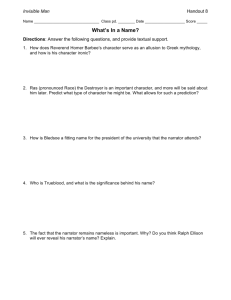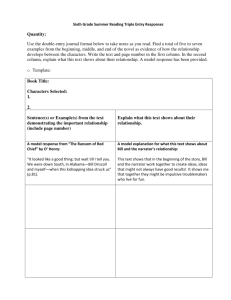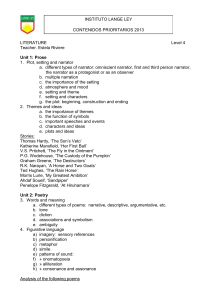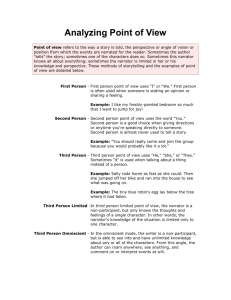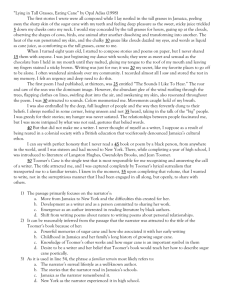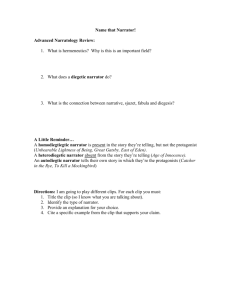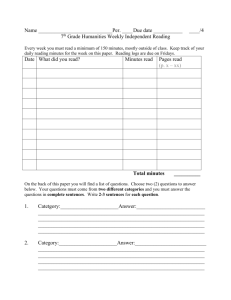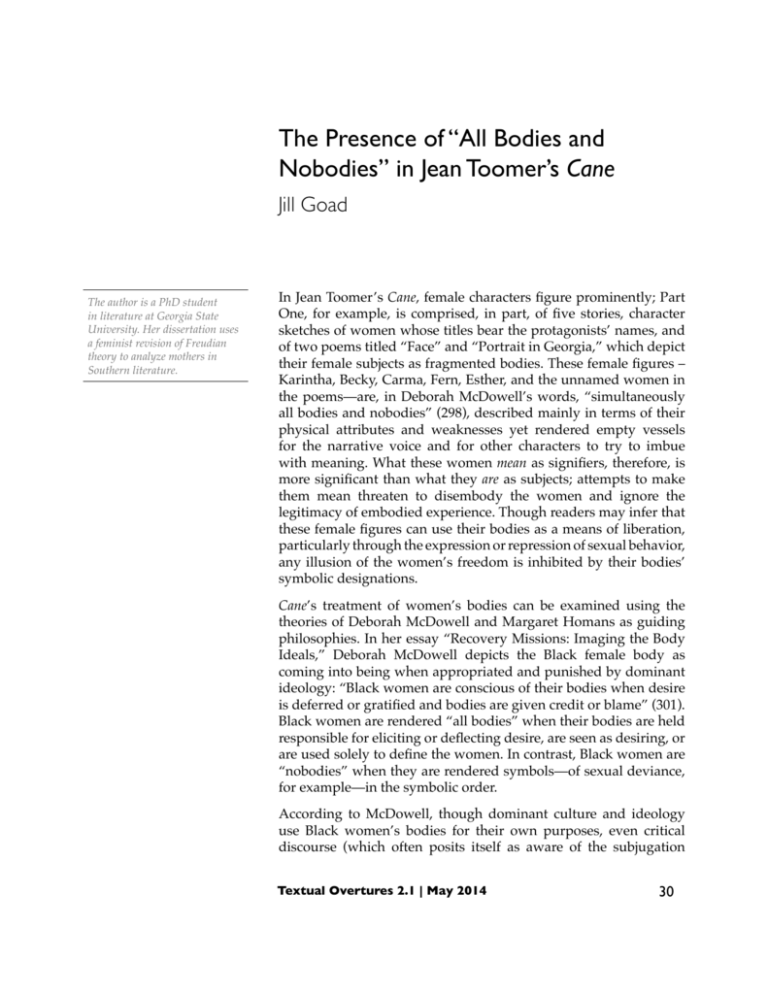
The Presence of “All Bodies and
Nobodies” in Jean Toomer’s Cane
Jill Goad
The author is a PhD student
in literature at Georgia State
University. Her dissertation uses
a feminist revision of Freudian
theory to analyze mothers in
Southern literature.
In Jean Toomer’s Cane, female characters figure prominently; Part
One, for example, is comprised, in part, of five stories, character
sketches of women whose titles bear the protagonists’ names, and
of two poems titled “Face” and “Portrait in Georgia,” which depict
their female subjects as fragmented bodies. These female figures –
Karintha, Becky, Carma, Fern, Esther, and the unnamed women in
the poems—are, in Deborah McDowell’s words, “simultaneously
all bodies and nobodies” (298), described mainly in terms of their
physical attributes and weaknesses yet rendered empty vessels
for the narrative voice and for other characters to try to imbue
with meaning. What these women mean as signifiers, therefore, is
more significant than what they are as subjects; attempts to make
them mean threaten to disembody the women and ignore the
legitimacy of embodied experience. Though readers may infer that
these female figures can use their bodies as a means of liberation,
particularly through the expression or repression of sexual behavior,
any illusion of the women’s freedom is inhibited by their bodies’
symbolic designations.
Cane’s treatment of women’s bodies can be examined using the
theories of Deborah McDowell and Margaret Homans as guiding
philosophies. In her essay “Recovery Missions: Imaging the Body
Ideals,” Deborah McDowell depicts the Black female body as
coming into being when appropriated and punished by dominant
ideology: “Black women are conscious of their bodies when desire
is deferred or gratified and bodies are given credit or blame” (301).
Black women are rendered “all bodies” when their bodies are held
responsible for eliciting or deflecting desire, are seen as desiring, or
are used solely to define the women. In contrast, Black women are
“nobodies” when they are rendered symbols—of sexual deviance,
for example—in the symbolic order.
According to McDowell, though dominant culture and ideology
use Black women’s bodies for their own purposes, even critical
discourse (which often posits itself as aware of the subjugation
Textual Overtures 2.1 | May 2014
30
dominant ideology perpetuates) is guilty of appropriating bodies;
it tries to classify all Black women’s bodies as “ideal” for discourse
because they are sites of resistance (301). Therefore, Black women’s
corporeal bodies, even when treated as “liberated,” are subject
to control. In resisting the idea that the body cannot be used as a
symbol or to make assumptions about the woman that possesses it,
McDowell notes, “body and self do not coincide; the body does not
constitute the sum total of the self… ’recovering’ the body requires
attending to its inside parts, its buried zones” (308). Ultimately,
McDowell advocates “a view of the body that perceives the
reciprocal relation between exterior and interior, between visible
and invisible ‘matter,’ between the outside and the inside number”
(309). This view of the body is much more complex than the one
presented in Cane.
Margaret Homans’ essay, “‘Racial Composition’: Metaphor and
the Body in the Writing of Race,” adds to McDowell’s discussion
of the Black female body in critical discourse by discussing the
impact of postmodern theory on bodies. According to Homans,
Black male critics such as Henry Louis Gates, Jr. and Houston
A. Baker, Jr. have, since the 1980s, advocated a deconstructionist
theoretical view of African-American texts. Female writers and
critics argue that this approach resists biological essentialism but
causes the body, the Black female body in particular, to vanish
because deconstructionism dismisses the validity of embodiment
and embodied experience. Female writers and critics who argue for
the body’s necessary presence in critical discourse and in literature
believe that “the body is experiential, including but not limited to
the erotic, and context-bound. It bears the traces of remembered
histories and is not separable from the mind” (Homans 80).
Homans cites Deborah McDowell to note that Black women’s
bodies and embodied experiences have been rendered instruments
for male literary critics: “the bodies/texts of black women have
become the ‘battlefield on and over which men, black and white,
[fight] to establish actual and symbolic political dominance and
to demonstrate masculine’ control” (McDowell qtd. in Homans
81). Instead of being valued in and of themselves as a facet of
subjectivity, bodies are taken away from their possessors and
dissected according to their symbolic purposes.
In Cane, female bodies are subject to such control because they are
rendered empty signifiers. According to Lacan, classifying the body
as signifier permits a negation of the person’s subjectivity: “[t]he
signifier does not designate what is not there, it engenders it. What
is not there, at the origin, is the subject itself” (Seminar XIV 8). In
the stories of Part One that are titled with their female characters’
names, there are no female subjects present, just symbolic figures
Textual Overtures 2.1 | May 2014
31
that are tied to the land, song, or physical objects such as houses,
and are summed up according to their sexual proclivities or lack
thereof. Though Darwin T. Turner argues that “the narrator…seeks
the soul, the feminine essence of women who in less artistic works
would be pitied or castigated as social outcasts” (208-209), Janet
Whyde’s assessment of the text’s purpose is more consistent with
the way Cane treats women: “As such, ‘woman’ in the first part is
obliterated and transformed through interpretation by an outside
agent – the narrator/speaker and/or male characters within the
individual sketches – into metaphor” (43).
Karintha, the title character of Cane’s opening story, is portrayed
as one of the dominant stereotypical images of Black women, the
jezebel. Darwin T. Turner praises Toomer for “[writing] lyrically
about Southern women isolated or destroyed because they have
ignored society’s restrictions on sexual behavior” (213), but his
narrators’ treatment of these figures is anything but sympathetic. In
her essay “Mammies, Matriarchs, and Other Controlling Images,”
Patricia Hill Collins defines the jezebel as “represent[ing] a deviant
Black female sexuality” (81). Jezebels have one foot over the line of
appropriate sexual behavior and are masculinized because of their
sexual aggressiveness. Karintha is an object of lust who entertains
multiple sexual partners and who, in keeping with the jezebel
characteristic of lack of sentimentality, abandons or murders her
child. Dominant ideology requires the presence of the jezebel to
show what is considered “inappropriate” sexual behavior, thus
drawing a line between the jezebel’s behavior and “normal” sexual
actions. The figure of the jezebel allows those who demonize her to
classify sexually active black women as dangerous, castrating, and
even deserving of unwanted sexual advances.
Though the narrator and other characters in the story play into
traditional stereotypes with characterization, or lack thereof, of this
title character, Karintha is also depicted in her story as equated with
nature. Introduced as “Karintha carrying beauty, perfect as dusk
when the sun goes down” (3), she is tied to the Georgia landscape.
Her movements are compared to that of a “black bird” and “red
dust,” her loveliness is akin to “a November cotton flower,” and her
soul is “a growing thing ripened too soon” (3-4). Karintha’s sexual
expression, a result of mimicking her parents’ sexual behaviors, is
also designated as ‘natural.’
However, her body’s connection to nature and natural resources
makes her ripe for exploitation, just as the land and those who
worked it in the antebellum and postwar South have been exploited,
according to William Dutch: “Karintha can be viewed as a stalk of
cane growing in the field along with other cane plants. People look
forward to her ripening for their pleasure and use” (266). Like cane,
Textual Overtures 2.1 | May 2014
32
which can be chewed to extract its last drops of sweetness, Karintha
is similarly decimated for the pleasure she promises. The woman as
land metaphor is one that renders the woman passive, put to use
as others see fit.
Though Karintha’s symbolic nature makes her mean rather than
be, a certain agency could be inferred from her taking on sexual
partners as often as she wishes. She seems to control potential suitors
with her magnetic sexuality, but they control her when their means
of “keeping her up” render her a prostitute and make her body
signify this role, “By regarding her as a prostitute, the men who
desire Karintha limit her to an existence defined by the tangible,
measurable quantities of body and money” (Blake 218). The life
that Karintha leads does not discount the presence of her body, but
the men who sleep with her and support her financially see nothing
but her body, since they and the narrator give no indication that
she is compelling for more than her beauty. Deborah McDowell’s
concept of the self as a combination of inner and outer elements
does not extend to Karintha’s characterization; readers never know
who she is, just what she is.
Catherine Kodat argues conversely that “the story of Karintha
is liberating insofar as it forces the reader to reflect on the larger
racial symbolism she is made to ‘carry’” (8). Karintha’s role as
jezebel can help critical discourse interrogate stereotypes of Black
women’s sexual behavior which have persisted since slavery times
to justify their sexual exploitation and subjugation. She could
also be seen as symbolic of the use and abuse of Southern land
through slavery. However, critical discourse using Karintha for this
purpose appropriates her body and renders it ideal for addressing
subjugation of Black women, making it an object as the narrator
does, albeit in a different fashion. A deconstructionist treatment of
Karintha as only a body to bear meaning splits her mind and her
body and risks perpetuating binaries that deconstructionist theory
is supposed to interrogate.
Since Karintha’s body is not her own, she vacillates between “all
body” and “nobody.” As “all body,” Karintha’s worth is derived
solely from her body’s ability to give pleasure and be taken over.
In contrast, as a “nobody,” beyond her symbolic functions, her
movements are described in ephemeral terms—she does not make
a mark on the ground when she moves, is compared to expansive
dusk, and carries something immaterial, beauty.
Becky, a vessel just as to Karintha to be filled with meaning, is a stark
contrast to Karintha in appearance and in the emotional reaction
she elicits; though white, her treatment by the narrator and by
the other characters makes her one of McDowell’s “all bodies and
Textual Overtures 2.1 | May 2014
33
nobodies.” First introduced by the narrator as grotesque, Becky is
pathetic, weighted down, unlike the light as air Karintha: “Her eyes
were sunken, her neck stringy, her breasts fallen…[m]outh setting
in a twist that held her eyes, harsh, vacant, staring…” (7). Janet
Whyde sees this description of Becky as one facet of the limbo she
remains in: “Within the narrative, [Becky’s] body disappears into
ellipses—the punctuation of absent words—and the description of
her body falls, quite literally, between the interpretation of her by
the white community…and by the black community” (44).
A white woman who has had a child with a Black man, Becky is
held at a distance by Black and white townsfolk alike, perceived
as contaminated and insane, and“[t]he narrator in this story allies
himself with the townspeople…adopt[ing] their fears” (Blake
220). Her sexual behavior is seen as unnatural, her engagement in
miscegenation not only the fault of the man crazy enough to touch
her but also her fault for going against prescribed behaviors. She,
like Karintha, is a jezebel, but her sexual deviance is intolerable,
whereas Karintha’s is excusable.
To move Becky’s offensive body and the contamination it represents
from sight, the townsfolk build her a house far away from everyone
else and hide her there, keeping her alive with offerings of food to
maintain her as a symbol of a sexual line that cannot be crossed.
Oddly, these offerings render Becky a goddess of sorts (Dutch 267)
who is placated with gifts lest she punish the townsfolk with a
glimpse of her tainted body. Though Becky’s sexuality ‘liberates’
her from the town, this liberation is dependent on her solitude.
Becky’s symbolic body serves a seemingly positive function for the
community but denies her any humanity or subjectivity: “Becky’s
miscegenetic act unites the blacks and whites in this community—
through their hatred and charity toward her—but it separates
her from the community” (Dutch 267). Becky as a symbol is not
empowered but empowers others: the townsfolk can see her as a
reminder of their non-deviance, and the narrator finds his voice
as an “I” when Becky dies (Kodat 9). To be a symbol, Becky has to
disappear, to no longer, as the townspeople can determine, have an
embodied existence.
Since Becky never emerges from the home, and only her son in the
yard holding a baby indicates that Becky is alive and has committed
miscegenation once again, her invisibility makes her house a standin for her body and a symbol to those who built it and those who
pass by it: “The house, built between a road and railroad tracks,
is a stationary reminder to those who are life’s travelers of their
innermost urges and deepest levels of conscience” (Eldridge
231). After her sons grow and leave, Becky stays hidden, only the
house serving as a reminder of her presence. Eventually, Becky the
Textual Overtures 2.1 | May 2014
34
human being is openly regarded as dead, a comfort to the narrator
and to the townsfolk who symbolically killed her years before
by filling her up with their words, rendering her a symbol, and
disembodying her by hiding her away at the edge of town. When
the narrator states, “Becky if dead might be a hant, and if alive—it
took some nerve even to mention it” (8), it is apparent that Becky’s
body as representation of moral failing is no longer needed—is,
in fact, frightening—for the townsfolk to mark the line between
appropriate and inappropriate sexual behavior. The house, an
inanimate stand-in for Becky, can serve the same symbolic purpose
without involving the woman who lives inside it.
No matter its use to the townsfolk, the house cannot stand forever
in denial of Becky’s embodiment; it collapses on its tenant, leaving
Becky literally an empty shell and showing that her body is the
cause of her tragic end. So frightened at the prospect of seeing
Becky’s body, which has for so long been rendered invisible, that
the narrator and Barlo leave her beneath the rubble. The Bible,
referred to by many adherents as the Word, which Barlo leaves
on top of Becky’s burial mound, is likely intended to give Becky
some spiritual release. However, it stands as a representation of the
inadequacy of language to lend subjectivity to human beings.
Ultimately, Becky vacillates between “all body” and “nobody”
more than any other female character in Part One. As “all body,”
Becky is vividly described as decaying, and the description of her
body renders her abject, boundary-breaching; as “nobody,” she
is made to disappear into the house built for her. Becky alive (all
body) is a bigger threat than Becky dead (nobody), because Becky
alive and visible has a disturbing gaze that disrupts the townsfolk’s
gaze. Becky alive and invisible is both “all body” and “nobody,”
creating a comforting limbo for the townsfolk.
In contrast to Becky, Carma initially seems larger than life in
her story in terms of physical strength: “Carma, in overalls, and
strong as any man” (12). Portrayed as a jezebel like Karintha and
Becky, Carma, though married, spends time with many lovers, is
masculinized, and seemingly lacks sentimentality. According to
the narrator, Carma is aware of and is perhaps confident about her
appeal: “Maybe she feels my gaze, perhaps she expects it” (12).
Though stereotypical, she seems initially to have more agency than
the other women in Part One, until the narrator renders her part of
“the crudest melodrama” (13).
Carma’s status as “all body” appears to, at first, leave no room
for her as “nobody.” She is strong and physically capable, and she
uses her body to achieve sexual satisfaction from a variety of men.
However, she is rendered both “all body” and “nobody” when
Textual Overtures 2.1 | May 2014
35
her husband, Bane, discovers her infidelity. The “[w]ords, like
corkscrews, [that] [worm] to her strength” (13) thrown at her by her
husband are consistent with the deconstructionist view of language
as the murder of the thing it designates, as disassociated from the
body and the sensual. Carma’s husband, by presumably labeling
her an adulterer or whore, renders her a symbol of inappropriate
sexual behavior, discounting her subjectivity and individuality. The
freedom from sexual mores that her body offers is an illusion, since
her husband claims her body after she flees from him into the cane
fields and uses it as a battlefield on which to express his feelings of
sexual jealousy. After a while, Carma becomes “dead weight” (13)
to her husband, a symbol of his failed masculinity.
Janet Whyde contends that the narrator, not Carma’s husband, is
responsible for oversimplifying both her as a character and her
experience: “[The narrator] succeeds in narratively destroying
Carma, reducing her story to a melodrama, by defining her body in
such a way that she no longer functions as a character, an individual”
(46). The narrator seems more fascinated by than sympathetic to
Carma, as he gazes upon her openly, says she should have other
lovers but blames her for her husband’s imprisonment, and
acknowledges that her story is what it is because he chose to tell it
that way. Carma’s story shows that she is subject to appropriation
because the narrator wants her to mean sexual deviance but not
be a woman whose subjectivity is beyond skin deep. The way the
narrator constructs this melodrama renders Carma a symbol of
uninhibited sexuality whose behaviors lead to men’s ruin; her body
takes the blame for inspiring frenzied desire.
The narrator’s symbolic treatment of Carma also links her to the
land. William Dutch argues that Karintha, Becky, and Carma are
represented as tied to nature and are like the cane that is cultivated
and appropriated, all its sweetness extracted. It is interesting, then,
that when Carma runs through the cane field, the narrator notes that
the stalks have no meaning in the field, just as time and space have
no meaning there (13). Carma is, therefore, an empty vessel that
vacillates between male and female, freedom and imprisonment,
put to any symbolic purpose she is needed for.
Carma, along with Karintha and Becky, is considered a jezebel figure.
The first three stories in Cane offer character sketches of sexually
expressive women, while the two later female-titled stories, “Fern”
and “Esther,” outline the symbolic qualities of sexually repressed
women. Dividing women in Cane according to their promiscuity
or refusal to engage in sexual activity brings to mind the virgin/
whore dichotomy. However, Toomer problematizes this dichotomy:
“whores” in the text are not roundly demonized by the speaker(s),
though the women’s sexual proclivities never leave them with a
Textual Overtures 2.1 | May 2014
36
happy ending. On the other hand, virgins are not posited as the
ideal, though they too are not demonized.
Fern, a “born-again virgin,” is the most vividly physically described
of all the women in Cane, but this description keeps her classified as
a symbol, since “[w]e learn nothing of Fern as a character, but we
learn much about Fern as a function” (Kodat 11). Her face and her
eyes, not the rest of her body, are focal points, for they seem fluid
and able to absorb the world around them:
Face flowed into her eyes. Flowed in soft cream foam and
plaintive ripples, in such a way that wherever your glance
may momentarily have rested, it immediately thereafter
wavered in the direction of her eyes…They were strange
eyes. In this, that they sought nothing—that is, nothing that
was obvious and tangible and that one could see, and they
gave the impression that nothing was to be denied…Like
her face, the whole countryside seemed to flow into her
eyes. (16-17)
Fern, like Karintha, has long inspired male devotion, perhaps
because she, too, has a light, fluid beauty that does not speak to
moral decay, unlike Becky’s grotesque figure, or to emasculation,
like Carma’s manlike strength and bearing. Her eyes, too, do not
possess Becky’s harsh, vacant, perhaps even condemning gaze:
“The eyes are so appealing because of a paradox: while they search
for nothing, they deny nothing” (Eldridge 232).
Beyond the extensive description of her, Fern functions as an “all
body” because her body is seen as the object of men’s frustrated and
gratified desires. Though reclaiming one’s virginity as Fern does
is abnormal in the South, according to the narrator, Fern’s body
is never blamed but simply given credit for its magnetism. Fern’s
body was once a source of sexual release for men, and readers
could infer that Fern empowers herself by subsequently refusing
sex because no one can give her what she desires. However, Fern’s
body places her within the virgin/whore dichotomy. When she has
sex, men see her as easy, but when she refuses sex, she is placed
on a pedestal to the point of being untouchable. Either way, she is
limited by others’ perceptions of her, as seen in the references to
gossiping townsfolk when she accompanies the narrator on a walk.
These perceptions of the townsfolk and of Fern’s past lovers play
into her “nobody” aspects. Fern is a vessel like Becky to hold what
people say about her: “Ultimately, the problem with Fern, as it is
with many of Toomer’s women, is that everything flows into her
but nothing flows back out” (Eldridge 233).
Fern as “nobody” further never seems actively connected to her
body. Sex or abstinence plays out on her as she passively waits for
Textual Overtures 2.1 | May 2014
37
the next man to come along, and even after a sexual encounter or
a conversation “[n]othing ever really happened…[n]othing ever
came to Fern” (19). As the narrator notes, Fern is always to be
found at home, inactive, available to anyone who wants to see her:
“you’d be most like to see her resting listless-like on the railing of
her porch, back propped against a post, head tilted a little forward
because there was a nail in the porch post” (17). Just as Fern never
removes the nail to give herself comfort, she drifts through life
allowing things to happen to her but never making them happen.
Men who slept with her in the past got no pleasure from the act
but felt attached to Fern, wanting to give her something to fulfill
her desire and their perceived obligation to her. Fern is a blank
slate, an empty vessel that men try to “fill up” with useless objects
and use in an attempt to reflect themselves positively. There is no
indication that she feels an attachment to her lovers or wants men
to prove their love to her. Fern, according to the narrator, seems
unaware of what she does to either encourage or turn off men’s
sexual advances, so she simply allows the men to stay or to go as
they please.
Though the men who use and worship Fern are culpable in
rendering her a symbol of either sexual magnetism or purity, the
narrator, who controls the image readers see of Fern, is the most
liable in disembodying her, just as he is in Carma’s story: “By
making her a subject for sociological speculation and discussing
her in a breezy, intimate, parenthetical tone of voice, the narrator
detaches himself from Fern and associates with an audience which
is, like himself, not-Southern, not-mystic, and not-Fern” (Blake
221). Just as in Becky’s story, the narrator allies himself against the
female protagonist and renders her other by vocalizing the collective
objectifying perspectives of her. Though the narrator seems to want
to analyze Fern, he also has other selfish purposes for her, “As a
type of blessed virgin Fern offers to the narrator salvation through
the sensations of mystical unification with his past and his people”
(Reilly 200). The narrator looks to Fern for enlightenment because
her emptiness makes her an apt vessel for expansive elements—
God, the land—to fill.
Part of Fern’s objectification involves her “nobody” status as a
symbol of the land. As with previous stories, the woman as land
metaphor empties the subject of her subjectivity to make her
represent agrarian nostalgia or a condemnation of the human
subjugation required to tame and appropriate the land. Nature
flows into Fern, tying her to the landscape but also filling her with
tension she cannot release, a tension the narrator compares to
“boiling sap” (19). If she could release the natural forces inside her,
Fern could possibly construct a selfhood based on inner and outer
Textual Overtures 2.1 | May 2014
38
elements; since, however, this “boiling sap” only briefly emerges
as inarticulate sound, Fern remains a signifier, not an individual.
As a signifier, Fern is also compared to song, which might initially
be flattering, since music has long been considered by major
philosophers to be boundary-breaching. Music also has dark
elements, though, being the closest representation of the traumatic
Real and being subject to interpretation by countless listeners who
want to make the music “mean.” Both Fern’s body-as-nature and
body-as-song make her vulnerable to imposed meaning, vulnerable
to presumptuous characters who feel she can give them something.
The final female protagonist with a self-titled story is Esther, a nearwhite, overly serious child who grows into a sexually repressed
woman. Esther is a distinctive figure from the other women in Part
One for four main reasons: her physical appearance is not wholly
pleasant or unpleasant, she comes close to eliciting sympathy
from the narrator, the narrator is able to speak to her thoughts and
dreams, and she has no history of sexual “impurity.” Nonetheless,
any semblance of agency or subjectivity that Esther has collapses in
favor of her status as a symbol of withheld sexual urges.
When Esther the girl is first introduced, she is described by the
narrator in terms of “ifs”: “Esther’s hair falls in soft curls about her
high-cheek-boned chalk-white face. Esther’s hair would be beautiful
if there were more gloss to it. And if her face were not prematurely
serious, one would call it pretty. Her cheeks are too flat and dead for
a girl of nine. Esther looks like a little white child, starched, frilled”
(22). Esther at twenty-two is less potentially appealing, having been
aged by loneliness, “Her hair thins. It looks like the dull silk on
puny corn ears. Her face pales until it is the color of the gray dust
that dances with dead cotton leaves” (25). Finally, Esther at twentyseven is exhausted from the lack of excitement that comes from
working day after day at her father’s grocery store, “Her body is
lean and beaten” (25). These descriptions render Esther “all body”
because her very nature is seen in her appearance and because her
body is affected through the years by her lack of sexual expression
and her boredom with daily existence. Anything she feels, her body
shows.
Though these physical descriptions of Esther distance the narrator
from her, making her subject to his gaze, this narrator (perhaps
the same or different individual from the one(s) in the rest of Part
One) looks deeply into Esther to examine her thoughts and dreams
in a not unsympathetic way. The narrator examines the indelible
impression Barlo’s spiritual trance has left on nine-year-old Esther,
which leads seven years later to Esther’s dream of having a “[b]
lack, singed, woolly, tobacco-juice baby—ugly as sin” (24) rescued
from a fire. In Esther’s dream, she longs for this baby to have come
Textual Overtures 2.1 | May 2014
39
immaculately and, though torn about the morality of wanting
this baby, keeps dreaming about possessing him. The narrator
depicts Esther’s ambivalence without judgment, even permitting
a sympathetic portrait of a girl so trained in conventional morality
that the moral boundaries she has been taught intrude on her one
indulgence—dreaming of her love for this child, which represents
her desire for completion, a desire she thinks can be fulfilled by
Barlo.
This dream, however, a reflection of her desire, reflects the desire
of the Other, which is dominant ideology; as Lacan notes, one’s
desire is always the desire of the Other. The dream would then
reflect that the Other wants women like Esther to be “complete”
through sexual behavior. Esther is an anomaly compared to the
other women in Part One because she has never engaged in sexual
behavior. Perhaps this renders her useless in society—no man wants
her because she has no sweetness, and her lack of beauty does not
even make her a pleasure to gaze on. Unlike Karintha, Carma, or
Fern, she can provide no pleasure or even a connection to the land.
Unlike Becky, she cannot be an example of immorality which others
can use as a basis of comparison. Through Esther, the implication is
made that the plain, sexually withheld woman is a symbol, but is
not useful enough to be appropriated.
The narrator never seems to use Esther as the other women are used,
but despite his examination of her inner thoughts, he ultimately
oversimplifies his subject, rendering her mainly in terms of her
repressed sexual desire. Contributing largely to this representation
of Esther as a symbol of sexual repression is the repetition of flames,
both in her dream and in the scene where Barlo comes back into
town, giving Esther the opportunity to reunite with the object of
her desire. Depicting Esther as an increasingly haggard shell with
inner fire the only element to speak to her repressed needs makes
her known only by her desire.
Esther’s singular obsession, to achieve “personal wholeness
through sexual union” (Blake 222), renders her a “nobody.” Her
main concern is why she is unappealing to men, and the purpose
that drives her existence is making Barlo and what he represents—
otherworldliness, strength—her own. When she realizes that Barlo
is a vulgar, “hideous” drunk, not the savior she wanted, Esther
feels that there is “no air, no street, and the town has completely
disappeared” (27). With her desire vanquished, she has no place,
showing that all that ever defined her was this desire.
Though Esther, along with the other women in Part One, is
rendered a symbolic, hardly individualistic figure, at least she and
these other women in the stories are given names, some semblance
Textual Overtures 2.1 | May 2014
40
of individuality, unlike the figures represented in two of Part One’s
poems, “Face” and “Portrait in Georgia.” Both poems are portraits
of women who represent, in the case of “Face,” suffering, and in
the case of “Portrait in Georgia,” destruction. The subjects of these
poems are fragmented, their body parts tied to aspects of history
embedded in the Southern landscape. Instead of examining the
subjectivity of Southern Black and white women, the poems are
only intended to make these bodies, which could be the bodies of
any women, mean something. Appropriating bodies as the means
to convey a message reaches its peak in Toomer’s poetry.
“Face,” which comes right after “Becky” in Cane, is the portrait of a
woman laborer who could be a slave or poor tenant farmer. Though
much of the poem does describe the subject’s face, particularly
brows and eyes, it also examines the woman’s hair and muscles, all
features compared to aspects of nature and the land: stars, canoes,
and grapes. Like Becky, the woman in “Face” is weighed down
with the effects of life, and, like Esther, her life experiences have
made their mark on her body, “Toomer designs the impression of
the woman by starting with her hair and continuing downward,
a movement which expresses the burden of life which the woman
has endured. The images therefore become heavier, beginning with
the stars and ending with cluster grapes” (Eldridge 226). Richard
Eldridge further remarks on this woman’s beauty as a result of her
experience, which is a consistent motif in Toomer’s work.
The poem’s opening lines compare the woman’s gray hair to
“streams of stars” (3), rendering it ethereal and intangible. In
contrast, her brows are “recurved canoes” (5), life having shaped
her as one might carve and shape wood into a canoe, and the result
of this carving is the mist of tears on her face. Strangely, and in
a way that parallels the description of Fern, the woman’s eyes
are mentioned, but they are never looked into. If the eyes are, to
borrow a trite phrase, “the windows into the soul,” the speaker’s
refusal to look into the woman’s eyes shows his refusal to see her
as an individual with a core self. Finally, the woman’s muscles are
compared to “cluster grapes of sorrow / purple in the evening sun
/ nearly ripe for worms” (11-13). This image ties the woman fully
to the land; like grapes, she has been cultivated for others’ benefit,
and having served her purpose, she is ready for death.
Though the woman’s body represents the toil in her life, thus
lending her a certain dignity for having survived her subjugation,
she is not able to tell her own story, the same predicament the other
women in Part One share. Subject to the speaker’s gaze, the woman
is simplified to the extent that she has to stand as a symbol of an
entire class, gender, and possibly race. In effect, the speaker renders
her body “ideal” in that it can indict the agrarian system in the
Textual Overtures 2.1 | May 2014
41
South for abusing humans in the name of progress and maintaining
the status quo. The woman in “Face,” therefore, is “all body” for
the same reason she is “nobody”—her body is all that readers are
presented as the sum of what she is.
“Portrait in Georgia,” which follows “Esther” and precedes “BloodBurning Moon,” uses the same structure as “Face” to render
symbolic the body of the white woman. Repeatedly, a body part of
the woman is named, followed by a hyphen, which is then followed
by an image used to describe that part. In this poem, images of
racial violence, particularly lynching, are associated with the body.
According to Bernard W. Bell, “The grim image of a woman in
‘Portrait in Georgia’ forcefully establishes the sexual link between
the Southern ritual of lynching and the myths of white purity and
Black bestiality” (226), while Richard Eldridge believes that the
poem “presents a picture of sexual frustration, like Toomer’s other
portraits of women who ultimately impose destruction upon those
who love them” (234). Both views can be accommodated in the
symbolic rendering of the poem’s subject, since the white woman
in the poem is used to interrogate what the dominance of whites in
the South was often predicated on: a violent reaction against Black
people and the myth of white moral superiority.
The fragmented body in “Portrait in Georgia” represents violence,
part by part. The woman’s hair is “coiled like a lyncher’s rope,”
(2), her eyes are “fagots” (3), her lips are “old scars, or the first red
blisters,” (4), and her body is “white as the ash / of black flesh
after flame” (6-7). One facet of the woman belies her violence, her
breath that is “the last sweet scent of cane,” (5), but this image
could show the woman’s false sweetness as exhibited in her speech.
This portrait of the body makes the woman lethally beautiful, her
pleasing features connected to tying up, whipping, and burning
Black bodies.
“Portrait in Georgia,” just like “Face,” renders its subject an empty
signifier by making one body stand for an entire class, race, and
gender. The woman is perceived by a speaker who both adheres to
and subverts traditional love poetry by listing the woman’s most
desirable features, but makes them ugly because they are marked
by an equally ugly history. The body of this subject is “all body”
in that it is abject, drawing the speaker’s gaze to it yet threatening
to consume all who come near it. This figure is “nobody” in that it
is responsible for carrying racial symbolism, but serves no other
purpose beyond a symbolic one.
Being “all bodies and nobodies” is what connects the women in Part
One of Cane. Never allowed to tell their own stories, these female
figures—Karintha, Becky, Carma, Fern, Esther, and the unnamed
Textual Overtures 2.1 | May 2014
42
women in the poems—are subject to dissection, interpretation,
and oversimplification by presumably male narrators and male
characters. Expected to bear the burden of representing the
complexity of the Southern landscape with its rules regarding racial
hierarchy and sexual expression, the women are never treated as
individuals, subjects whose selves are comprised of an exterior
and an interior. To “recover” these bodies as Deborah McDowell
wishes would be done for all Black female bodies would entail not
only interrogating why these women are silenced and rendered
metaphor, but also imagining what their stories, their voices, would
communicate.
Textual Overtures 2.1 | May 2014
43
Works Cited
Bell, Bernard W. “The Poems of Cane.” Black World (Sept. 1974): 1316. Rpt. in Cane: An Authoritative Text, Backgrounds, Criticism. Ed.
Darwin T. Turner. New York: W.W. Norton, 1988. Print.
Blake, Susan L. “The Spectatorial Artist in Part One of Cane.” CLA
Journal 17 (June 1974): 516-34. Rpt. in Cane: An Authoritative Text,
Backgrounds, Criticism. Ed. Darwin T. Turner. New York: W.W.
Norton, 1988. Print.
Collins, Patricia Hill. “Mammies, Matriarchs, and Other
Controlling Images.” Black Feminist Thought: Knowledge,
Consciousness, and the Politics of Empowerment. 2nd ed. New
York: Routledge, 2000. Print.
Dutch, William L. “Three Enigmas: Karintha, Becky, and Carma.”
Jean Toomer: A Critical Evaluation. Ed. Therman B. O’Daniel.
Washington, D.C.: Howard UP, 1988. Print.
Eldridge, Richard. “The Unifying Images in Part One of Jean
Toomer’s Cane.” Jean Toomer: A Critical Evaluation. Ed. Therman
B. O’Daniel. Washington, D.C.: Howard UP, 1988. Print.
Homans, Margaret. “’Racial Composition’: Metaphor and the
Body in the Writing of Race.” Female Subjects in Black and White:
Race, Psychoanalysis, Feminism. Ed. Elizabeth Abel, Barbara
Christian, and Helene Moglen. Berkeley: U of California Press,
1997. Print.
Kodat, Catherine Gunther. “To ‘Flash White Light from Ebony’:
The Problem of Modernism in Jean Toomer’s Cane.” Twentieth
Century Literature 46.1 (Spring 2000): 1-19. Print.
Lacan, Jacques. Seminar XIV: The Logic of Phantasy. Trans. Cormac
Gallagher, 1966-67. Print.
McDowell, Deborah E. “Recovery Missions: Imaging the Body
Ideals.” Recovering the Black Female Body: Self-Representations by
African American Women. Ed. Michael Bennett and Vanessa D.
Dickerson. New Brunswick: Rutgers UP, 2001. Print.
Reilly, John M. “The Search for Black Redemption: Jean Toomer’s
Cane.” Studies in the Novel 2 (Fall 1970): 312-24. Rpt. in Cane: An
Authoritative Text, Backgrounds, Criticism. Ed. Darwin T. Turner.
New York: W.W. Norton, 1988. Print.
Toomer, Jean. Cane. Norton Critical Edition. Ed. Darwin T. Turner.
New York: W.W. Norton, 1988. Print.
Turner, Darwin T. “Contrasts and Limitations in Cane.” In a Minor
Textual Overtures 2.1 | May 2014
44
Chord: Three Afro-American Writers and Their Search for Identity.
Carbondale and Edwardsville: Southern Illinois UP, 1971. Rpt.
in Cane: An Authoritative Text, Backgrounds, Criticism. Ed. Darwin
T. Turner. New York: W.W. Norton, 1988. Print.
Whyde, Janet M. “Narrating the Body in Jean Toomer’s Cane.” The
Southern Literary Journal 26.1 (Fall 1993): 42-53. Print.
Textual Overtures 2.1 | May 2014
45

